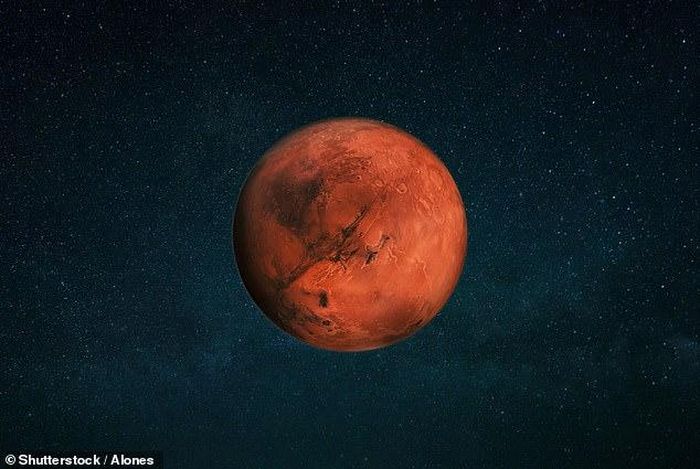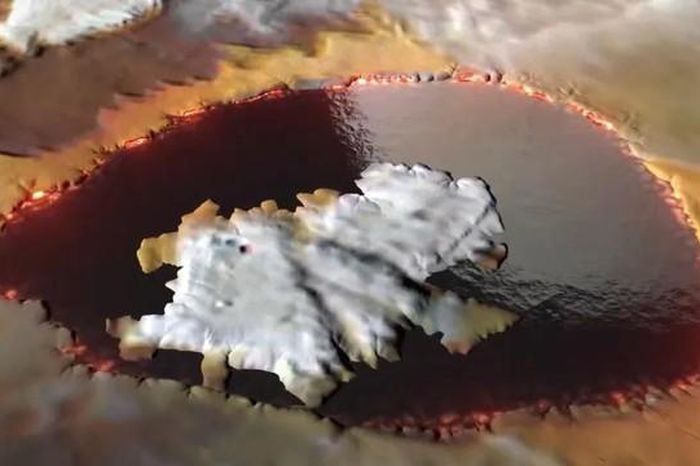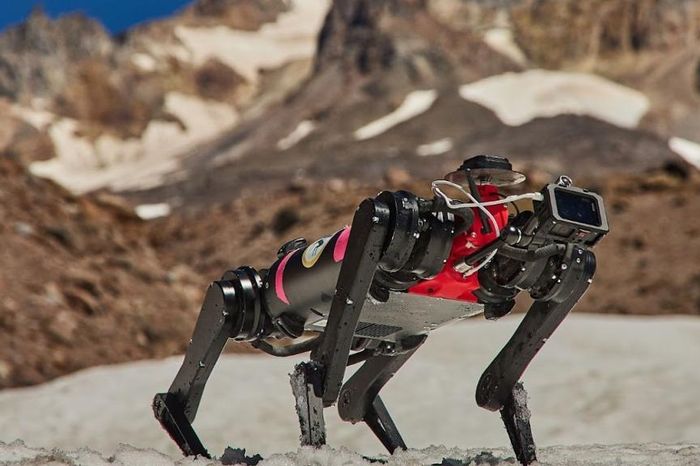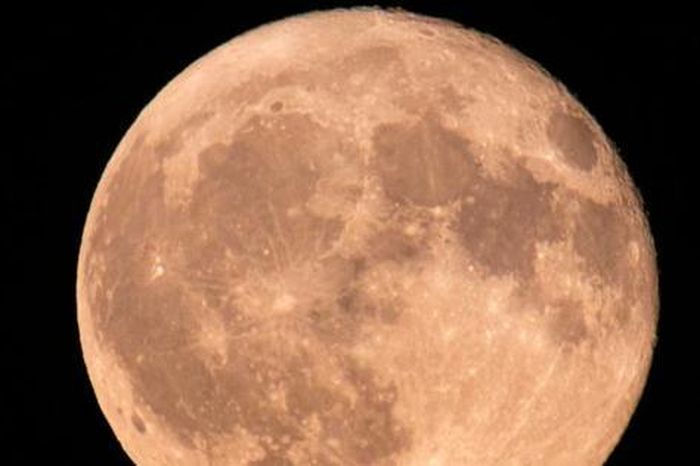NASA found traces of methane gas near a crater on Mars

According to the Daily Mail (UK), NASA's Curiosity probe has detected a steady flow of methane gas from Gale crater, appearing at different times of the day and fluctuating seasonally, sometimes reaching double highs. 40 times more than normal.
Although life has not yet been found on the world of Mars, NASA scientists believe that this gas flow may originate from deep underground.
The team thinks the methane could be trapped under a layer of solidified salt and only escape when temperatures on Mars rise – or when the Curiosity rover rolls over the crust and cracks it.
On Earth, this simple molecule, made up of one carbon atom and four hydrogen atoms, is often a sign of life. Methane gas is often released by animals when digesting food.
NASA's Curiosity probe has been roaming the surface of Mars since 2012. During that time until now, the most puzzling thing Curiosity has found is a steady stream of methane gas from Gale crater.
Gale Crater is the only location on the red planet where Curiosity has detected this plume. But NASA's probe has yet to detect any life on Mars.
With experiments simulating soil conditions on Mars, scientists seem to have answers to possible hypotheses.
Over a long period of time, salt will emerge from deep beneath the dusty, rock-covered topsoil of Mars. This salt is called perchlorate, a toxic substance that is abundant in ice trapped under the surface of Mars.
When there is too little air, the ice will gradually evaporate. And when this salty vapor filters through the topsoil, it leaves something behind.
When enough salts accumulate in the topsoil, they form a crust - like sand on the beach when it dries to a brittle crust, or like coffee grounds left behind after drinking.
On Mars, this process occurs naturally over a long period of time in shallow permafrost regions and may have enough salt, say the scientists behind the study published in JGR Planets. accumulates in the top layer. When the salt vapor bubbles up, methane gas also escapes.
But the origin of this gas stream is still a mystery. Methane could be emitted by some types of living organisms, or it could come from geological processes beneath the Martian surface that scientists have yet to explore.
But no matter where it originates, methane gas ends up trapped under this salt crust.
By pumping different concentrations of perchlorate through simulated Martian topsoil, scientists found that this impermeable crust formed in about 3 to 13 days. Perchlorate concentrations of 5 – 10% can create a solid salt crust.
Scientists pumped neon gas under the crust to replace methane. They confirmed that the shell is strong enough to trap methane underneath.
But when the planet's temperature rises at certain times of the day or during certain seasons, this shell ruptures, allowing methane to escape. And maybe that's when the Curiosity probe discovered methane in the air on Mars.
However, it's not just temperature that can crack this shell.
The crust can be about 2 cm thick. Curiosity is heavy enough to punch through it as it moves through.
'To test this hypothesis, methane measurements need to be taken when the rover reaches a site with high salt content. Another test is to try to suck in Martian air while drilling into the salt-rich surface,' scientists said.
But NASA has not yet conducted this experiment.
You should read it
- Here's your chance to design a NASA payload for a Roomba-sized moon rover
- NASA opens the entire library of photos, videos and audio for free, anyone can see
- NASA will prioritize the recruitment of experienced scientists in blockchain and cryptocurrency
- NASA's top secret inventions have just been revealed
- Clip NASA: 'Glass lake' in the most terrible place in the solar system
- NASA launches new Sun tracking tool
- Did NASA ships indirectly bombard other planets?
- Why didn't NASA intend to return to the Moon?
May be interested
- NASA built 3D working tools with Martian rocks and dust
 nasa scientists have successfully built repair and labor tools made of moon dust, mars prepares for a journey of discovery, even for the prospect of living on mars by 2030. .
nasa scientists have successfully built repair and labor tools made of moon dust, mars prepares for a journey of discovery, even for the prospect of living on mars by 2030. . - 5 most interesting findings about Red Planet
 mars has always attracted the attention of scientists. people have sent a lot of probes to discover interesting things in this red planet. the findings below will certainly surprise you.
mars has always attracted the attention of scientists. people have sent a lot of probes to discover interesting things in this red planet. the findings below will certainly surprise you. - Over 12,000 people applied to fly to the moon and Mars as NASA Artemis astronauts
 as it turns out, a whole lot of people would like to visit the moon (and mars). nasa has received over 12,000 applications for its next class of astronauts, it announced this week.
as it turns out, a whole lot of people would like to visit the moon (and mars). nasa has received over 12,000 applications for its next class of astronauts, it announced this week. - NASA began assembling Mars 2020 spacecraft
 nasa is carrying out the mission of the mars 2020 ship in july 2020 because this space agency started the component, test and start (atlo) phase of the project at the trans-asia space processing facility. 1 at the jet engine laboratory (jpl) in pasadena, california.
nasa is carrying out the mission of the mars 2020 ship in july 2020 because this space agency started the component, test and start (atlo) phase of the project at the trans-asia space processing facility. 1 at the jet engine laboratory (jpl) in pasadena, california. - NASA imagines a whimsical dragon on Mars in a sinuous, scenic canyon
 combine an active imagination with an image of mars and you may spot a shag carpet, a star trek insignia or even pac-man on the red planet.
combine an active imagination with an image of mars and you may spot a shag carpet, a star trek insignia or even pac-man on the red planet. - Find strong evidence of life on Mars
 mars has been one of the most interesting astronomy planets in recent years.
mars has been one of the most interesting astronomy planets in recent years. - NASA rover shares stunning images of Mars' moon Deimos
 nasa's perseverance rover - which has been on a mission to explore the surface of mars since 2021 - has just shared a stunning image of deimos, one of the red planet's two moons, back to earth.
nasa's perseverance rover - which has been on a mission to explore the surface of mars since 2021 - has just shared a stunning image of deimos, one of the red planet's two moons, back to earth. - Science test: Potatoes can be grown on Mars
 research scientists have demonstrated that potatoes can grow in a simulated environment of radiation, temperature, air pressure, oxygen and the level of carbon dioxide similar to the surface of mars.
research scientists have demonstrated that potatoes can grow in a simulated environment of radiation, temperature, air pressure, oxygen and the level of carbon dioxide similar to the surface of mars. - NASA's Perseverance rover is carrying an inspiring coded message to Mars
 too bad there aren't any aliens there to read it.
too bad there aren't any aliens there to read it. - Mars: Overview of the 4th planet in the solar system
 how big is mars? what is the mass of mars? let's find out with tipsmake.com.com what you need to know about the red planet!
how big is mars? what is the mass of mars? let's find out with tipsmake.com.com what you need to know about the red planet!










 The Voyager 1 spacecraft sent signals to Earth for the first time in 5 months
The Voyager 1 spacecraft sent signals to Earth for the first time in 5 months The Voyager 1 spacecraft resumes sending technical updates back to Earth
The Voyager 1 spacecraft resumes sending technical updates back to Earth Hubble telescope discovers more than 1,000 new asteroids
Hubble telescope discovers more than 1,000 new asteroids Clip NASA: 'Glass lake' in the most terrible place in the solar system
Clip NASA: 'Glass lake' in the most terrible place in the solar system The US conducted a robot test operating on the Moon
The US conducted a robot test operating on the Moon Why does NASA want to set a time zone for the Moon?
Why does NASA want to set a time zone for the Moon?